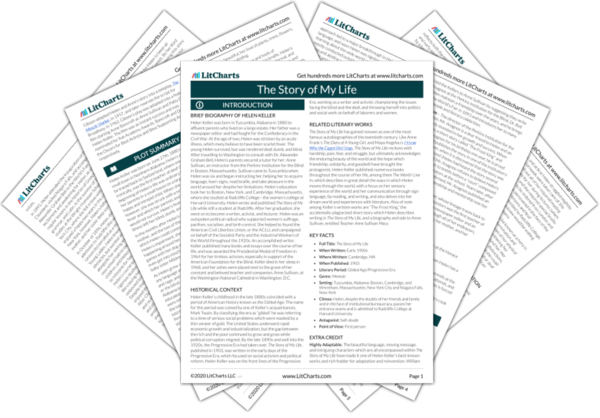Brief Biography of Helen Keller
Helen Keller was born in Tuscumbia, Alabama in 1880 to affluent parents who lived on a large estate. Her father was a newspaper editor and had fought for the Confederacy in the Civil War. At the age of two, Helen was stricken by an acute illness, which many believe to have been scarlet fever. The young Helen survived, but was rendered deaf, dumb, and blind. After travelling to Washington to consult with Dr. Alexander Graham Bell, Helen’s parents secured a tutor for her: Anne Sullivan, an instructor from the Perkins Institution for the Blind in Boston, Massachusetts. Sullivan came to Tuscumbia when Helen was six and began instructing her, helping her to acquire language, learn signs, read braille, and take pleasure in the world around her despite her limitations. Helen’s education took her to Boston, New York, and Cambridge, Massachusetts, where she studied at Radcliffe College—the women’s college at Harvard University. Helen wrote and published The Story of My Life while still a student at Radcliffe. After her graduation, she went on to become a writer, activist, and lecturer. Helen was an outspoken political radical who supported women’s suffrage, pacifism, socialism, and birth control. She helped to found the American Civil Liberties Union, or the ACLU, and campaigned on behalf of the Socialist Party and the Industrial Workers of the World throughout the 1920s. An accomplished writer, Keller published many books and essays over the course of her life, and was awarded the Presidential Medal of Freedom in 1964 for her tireless activism, especially in support of the American Foundation for the Blind. Keller died in her sleep in 1968, and her ashes were placed next to the grave of her constant and beloved teacher and companion, Anne Sullivan, at the Washington National Cathedral in Washington, D.C.
Historical Context of The Story of My Life
Helen Keller’s childhood in the late 1880s coincided with a period of American history known as the Gilded Age. The name for this period was coined by one of Keller’s acquaintances, Mark Twain. By classifying the era as “gilded” he was referring to a time of serious social problems which were masked by a thin veneer of gold. The United States underwent rapid economic growth and industrialization, but the gap between the rich and the poor continued to grow and grow while political corruption reigned. By the late 1890s and well into the 1920s, the Progressive Era had taken over. The Story of My Life, published in 1903, was written in the early days of the Progressive Era, which focused on social activism and political reform. Helen Keller was on the front lines of the Progressive Era, working as a writer and activist, championing the issues facing the blind and the deaf, and throwing herself into politics and social work on behalf of laborers and women.
Other Books Related to The Story of My Life
The Story of My Life has gained renown as one of the most famous autobiographies of the twentieth century. Like Anne Frank’s
The Diary of A Young Girl, and Maya Angelou’s
I Know Why the Caged Bird Sings,
The Story of My Life reckons with hardship, pain, fear, and struggle, but ultimately acknowledges the enduring beauty of the world and the hope which friendship, solidarity, and goodwill have brought the protagonist. Helen Keller published numerous books throughout the course of her life, among them
The World I Live In, which describes in great detail the ways in which Helen moves through the world, with a focus on her sensory experience of the world and her communication through sign language, lip reading, and writing, and also delves into her dream world and experiences with literature. Also of note among Keller’s written works are “The Frost King,” the accidentally-plagiarized short story which Helen describes writing in
The Story of My Life, and a biography and ode to Anne Sullivan, entitled
Teacher: Anne Sullivan Macy.
Key Facts about The Story of My Life
-
Full Title: The Story of My Life
-
When Written: Early 1900s
-
Where Written: Cambridge, MA
-
When Published: 1903
-
Literary Period: Gilded Age/Progressive Era
-
Genre: Memoir
-
Setting: Tuscumbia, Alabama; Boston, Cambridge, and Wrentham, Massachusetts; New York City and Niagara Falls, New York
-
Climax: Helen, despite the doubts of her friends and family and in the face of institutional bureaucracy, passes her entrance exams and is admitted to Radcliffe College at Harvard University
-
Antagonist: Self-doubt
-
Point of View: First person
Extra Credit for The Story of My Life








